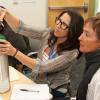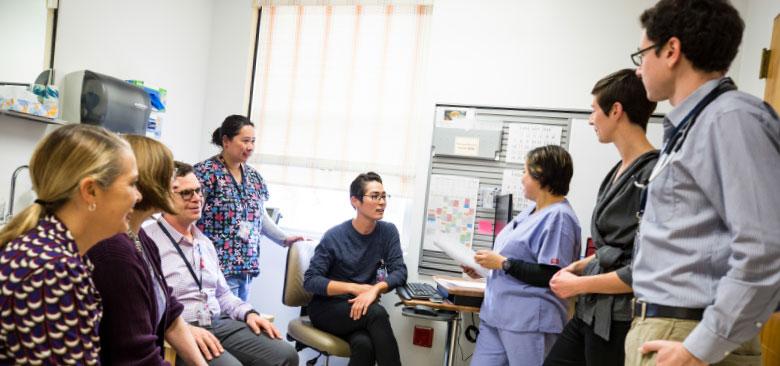
From left: Co-director Rebecca Shunk, faculty member JoAnne Saxe, psychiatric mental health NP James Caldwell, registered nurse Cora Aquino, NP resident Haruka Kelley, nurse Marbing Pablico, co-director Anna Strewler and physician resident Max Brondfield.
A Growing Partnership to Improve the Care of Veterans
Though the San Francisco VA Health Care System (SFVAHCS) has long been a clinical training site for the UC San Francisco School of Nursing, in the past few years, a series of innovative education and research collaborations are helping to improve the health of Bay Area veterans. Such collaborations are poised to grow.
“The VA offers a rich training ground for our students, fertile ground for joint research and an opportunity for our School to play a part in improving care for our veterans,” says Dean Catherine Gilliss of the School.
“There is a lot we can share,” says Mary Ann Nihart, interim associate director for patient care and nursing services at SFVAHCS and a volunteer faculty member at the School. “UCSF is the number one nursing school in the country, our VA is the top VA research facility in the country, and I’d like to see our relationship continue to develop and grow.”
EdPACT Leads the Way
In 2011 – convinced that team-based, relationship-centered primary care was worth a significant investment – the SFVAHCS ramped up its efforts to implement what it calls Patient Aligned Care Teams (PACT). After receiving a five-year, $5 million grant to become a designated VA Center of Excellence in Primary Care Education (CoEPCE), the SFVAHCS created its Education in Patient Aligned Care Teams (EdPACT) program, a collaboration among the SFVAHCS, the UCSF schools of medicine and nursing and UCSF Medical Education. In the ensuing years, the VA’s PACTs have become a model for other health systems within and outside the VA, and EdPACT was refunded for four years at $750,000 per year.
The School’s Susan Janson, JoAnne Saxe and Suzan Stringari-Murray co-developed the original EdPACT curriculum with UCSF physician Rebecca Shunk, who co-directs EdPACT, and Bridget O’Brien, who directs its curriculum design and evaluation. In EdPACT, second-year NP students train alongside medical residents, with each practitioner managing his or her own patient panels in collaboration with NP and physician preceptors and other members of the PACT, who include pharmacy residents, psychology fellows, social work interns and dietitian residents. In 2012, EdPACT added an NP residency program.
“As an integrated health care system, we have one and only one goal: the best care of veterans,” says Shunk, who also serves as the SFVAHCS’s associate chief of staff for education. “I believed early on that meant working in interprofessional teams; flattening the hierarchy and eliminating the bias among physicians against NPs that can exist in the outside world. Given the growing shortage of primary care providers, there is enough work for all of us, and it’s counterintuitive to have an adversarial relationship.”
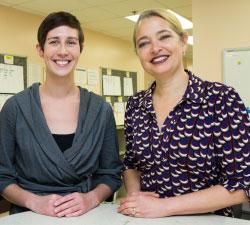 EdPACT co-directors Anna Strewler (left) and Rebecca Shunk In addition to the side-by-side training with medical residents and exposure to a clinical environment fully invested in team-based care, the SFVAHCS offers NPs other unique advantages. These include dedicated time for NPs to precept students and the VA having recently passed full practice authority for NPs.
EdPACT co-directors Anna Strewler (left) and Rebecca Shunk In addition to the side-by-side training with medical residents and exposure to a clinical environment fully invested in team-based care, the SFVAHCS offers NPs other unique advantages. These include dedicated time for NPs to precept students and the VA having recently passed full practice authority for NPs.
“Full practice authority here surpasses state scope of practice and has the potential to further strengthen the role of the VA in training and developing advanced practice nurses,” says EdPACT and NP residency graduate Anna Strewler, who now co-directs EdPACT with Shunk.
A Powerful Education in Team-Based Care
EdPACT incorporates key emerging concepts aimed at improving health care in the United States, from shared decision making and interprofessional collaboration through an increased emphasis on performance improvement and an expanded role for NPs.
“It adds up to highly patient-centered care, where we connect patients with whatever team member is the best fit,” says Strewler.
Saxe and Shunk add that the genuine investment in people getting to know and respect the skill sets of their colleagues in culturally appropriate ways not only builds effective teams, but also translates into improved relationships between health care providers and their patients.
For example, with a hypertensive patient who has never been on medication before, the team might have a pharmacy resident and a registered nurse take the lead for both education and follow-up blood pressure checks, allowing other members of the team to focus on other aspects of primary care. Another patient is on four blood pressure medications, but his depression, brought on by the recent death of his spouse, might be compromising his ability to pay attention to his own care. In such a case, PACT members might use their morning huddle to arrange a warm handoff – a transfer of care that occurs in front of the patient (and family, if present) – to a psychology fellow for connection to treatment for grief concerns and behavior modification aimed at improving medication adherence.
All agree that NP students enrolled in EdPACT get pushed beyond traditional NP training models, creating cohorts of well-prepared first-year NPs. And patient surveys show high levels of satisfaction with EdPACT trainee providers.
“We also do a lot of interprofessional, trainee-driven QI [quality improvement] projects, with more rigor and application of QI tools than you would do in a clinic setting without trainees,” says physician Maya Dulay, EdPACT associate director for clinical care and education. “When we do this type of education successfully, we help trainees learn valuable skills and implement important changes within our own clinical systems.”
 JoAnne Saxe “We’ve also brought many of these ideas back to the School of Nursing to see if our model can be replicated in other systems,” says Saxe. “We’ve even redesigned one of our courses on the patient-centered medical home, based on the work we do here.”
JoAnne Saxe “We’ve also brought many of these ideas back to the School of Nursing to see if our model can be replicated in other systems,” says Saxe. “We’ve even redesigned one of our courses on the patient-centered medical home, based on the work we do here.”
The EdPACT curriculum also recognizes that because the training is so intense, trainees need and receive attentive psychological support throughout their time at the SFVAHCS. In fact, restoring the joy of practicing primary care and preventing burnout have been at the center of the curriculum since its inception.
“The result is – and our evaluations confirm this – that our NP students are very satisfied and believe they have had a higher-quality experience than they might have had elsewhere,” says Saxe.
The group’s measures of team culture and perceptions of team performance have been consistently strong and have gotten better over the course of each cohort’s time at the VA. Moreover, a number of the NP trainees have stayed at the SFVAHCS or gone on to other VAs and become leaders in evidence-based innovations for both primary and specialty care – and the PACT concept has now spread to the inpatient setting at the SFVAHCS.
“We’ve gone from teaching NP residents and students to hiring them, so they can teach the next generation our shared vision for what interprofessional collaboration can be,” says Shunk.
The Residencies
Integrating an NP residency has further enriched EdPACT. Full-time NP residents see patients, complete clinical rotations in specialty areas of their choice, receive leadership training and help teach the EdPACT curriculum.
“The leadership and education components have positioned our residents to step into health care in an academic environment and attend to other roles,” says Saxe. “Some graduates teach in our Adult-Gerontology Primary Care Nurse Practitioner [AGPCNP] program, and Anna [Strewler] was involved in designing a geriatric standardized patient experience with the goal of providing depth around caring for older adults…especially since not all our students have the opportunity to work with frail older adults on things like advanced care planning, complicated medication regimes and oral health.”
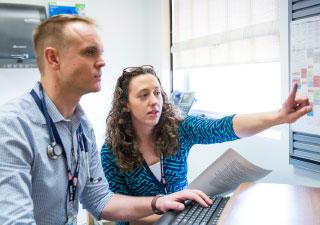 Krista Gager (right) serves as preceptor to Charles Noyes, nurse practitioner in training and also a veteran. “When I went to school to become an NP, becoming a clinical educator was not on my career list, but because of the residency – and having mentors and colleagues who showed me how I could craft a career that combines care and teaching – I’ve made that choice,” says Krista Gager, who graduated from both the AGPCNP and NP residency programs and is a key player in maintaining a bridge between UCSF and the SFVAHCS in her role as EdPACT associate NP director.
Krista Gager (right) serves as preceptor to Charles Noyes, nurse practitioner in training and also a veteran. “When I went to school to become an NP, becoming a clinical educator was not on my career list, but because of the residency – and having mentors and colleagues who showed me how I could craft a career that combines care and teaching – I’ve made that choice,” says Krista Gager, who graduated from both the AGPCNP and NP residency programs and is a key player in maintaining a bridge between UCSF and the SFVAHCS in her role as EdPACT associate NP director.
She co-facilitates weekly clinical conferences between EdPACT’s NP students and faculty that address specific patient cases and conditions, while providing insights into the system thinking that influences care. AGPCNP students also get the benefit of consulting with current NP residents, who are recent graduates of their own program.
The success of the EdPACT NP residency also helped spark the creation of a psychiatric/mental health NP residency at the SFVAHCS, the brainchild of Nihart and the School’s Bethany Phoenix. The first 100 percent nursing-driven initiative of its type at the SFVAHCS, the program is already proving to be a valuable asset.
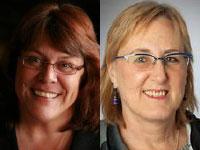 Mary Ann Nihart (left) and Bethany Phoenix “We are exceeding [the VA’s] national benchmarks for productivity, a measure of workload based on complexity and volume,” says Nihart. “The presence of the residents has us doing about a third again more visits with veterans than we did before we had the residency. This creates more access and frees up our faculty to see more veterans.”
Mary Ann Nihart (left) and Bethany Phoenix “We are exceeding [the VA’s] national benchmarks for productivity, a measure of workload based on complexity and volume,” says Nihart. “The presence of the residents has us doing about a third again more visits with veterans than we did before we had the residency. This creates more access and frees up our faculty to see more veterans.”
It’s perhaps equally exciting that the residency is forging a new way to create joint appointments that benefit both institutions. “The faculty members are privileged here and do their clinical hours here, supervising trainees and residents. It works out to a real live joint appointment,” says Nihart.
This, in turn, increases the level of trust between the two institutions. “Our VA faculty members will go to the UCSF faculty members, such as Matt Tierney and Katelyn Brady, for consults. They know, for example, that Matt is a nationally recognized expert in a specific intervention for substance abuse. We are both getting every bit of the bang for our buck, and this residency demonstrates our strong relationship – a relationship we both need.”
Discovering New Research and Quality Improvement Opportunities
That point is driven home further as the two institutions explore new ways to forge mutually beneficial research opportunities. In December 2016, the School’s Linda Park worked with Mary Whooley, a VA physician-researcher and faculty member in the UCSF departments of medicine and epidemiology & biostatistics, to garner a $1.1 million, four-year grant from the VA’s Nursing Research Initiative. The project will test which modality – text messaging, the use of a mobile app or a website – best improves medication adherence for patients with ischemic heart disease. After completing a series of qualitative interviews, Park and her team will begin recruitment of 225 veterans for the trial this January.
“We believe there are real opportunities for growth in mobile health adoption among veterans, because the percentage who have smartphones or understand how to use them is smaller than in the rest of the population,” says Park. “But we are confident the gap in knowledge and experience will shrink over the next 10 years.”
Park’s dual appointment solely for research broke important ground, in part, she says, because, “The research opportunities at the VA are incredible and largely untapped by nursing because you can’t receive an award unless you have an official appointment there and this, traditionally, has been difficult [for UCSF nursing faculty],” she says. “But when we can share resources, we can do more research on an important group that has socioeconomic challenges and complex medical problems – a population that is important to study from the nursing side. And the VA’s rich databases are a huge bonus.”
Whooley says such research is a path both to taking better care of veterans and to helping fulfill the VA’s legislated mission to conduct training in health professions, including mentoring a variety of VA researchers. She hopes to create a new center of excellence, along with a postdoctoral nursing scholarship that will build the nurse research side in the VA.
“Physicians sometimes think we’ll do research and the nurses will implement, but we really need to understand how nurses experience the health care system to ask the right questions and address the needs of patients,” says Whooley. “Linda is one of the first nurses who is straddling both sides of this academic affiliation and a poster child for changing the paradigm of how we can better work together.”
Nihart says that she expects conducting joint nursing research and evidence-based quality improvement projects will be an increasing part of how the two institutions collaborate. “Faculty from UCSF – like Mary Foley, who has been a key mentor for our evidence-based practice symposium for nursing – have brought a real change in nursing at the boots-on-the-ground level,” she says. “They raise the caliber of what we do. In the past, we went to the literature, but we didn’t have our own people doing data collection here on-site. Real-world, real-time evidence is a better argument for going ahead and changing policy.”
Finding New Opportunities to Work Together
All of this success is encouraging people in both institutions to seek new ways to collaborate.
“I’m excited by the School’s new DNP program, because the VA is very much inclined to have more DNPs on staff to drive evidence-based practice change – and to send our clinicians to UCSF to receive DNP degrees,” says Nihart. She also encourages SFVAHCS nurses to enroll in the School’s Master of Science Healthcare Administration and Interprofessional Leadership (MS-HAIL) program.
“UCSF students have the opportunity to see a mission-driven place like ours in action and to get unprecedented experience and training,” she adds. “And the UCSF students and faculty are constantly bringing in new information to address the challenges we face, so we get new, creative, problem-solving approaches to delivering care for our veterans.”


